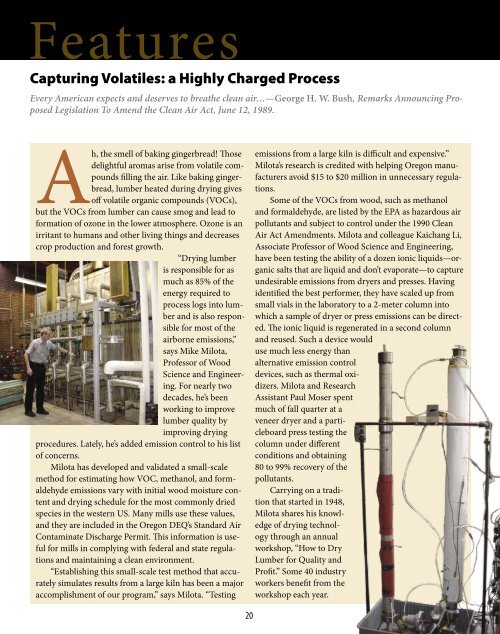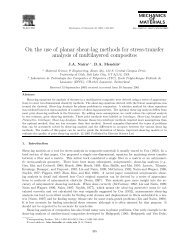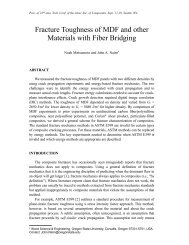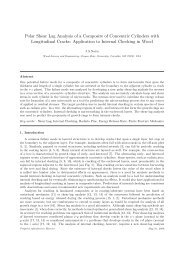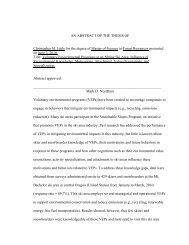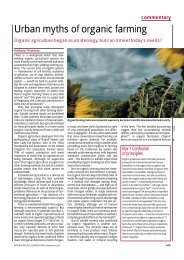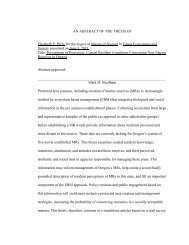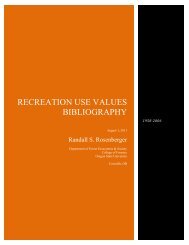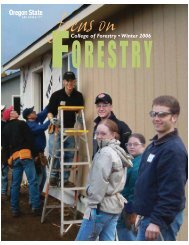College of Forestry - Oregon State University
College of Forestry - Oregon State University
College of Forestry - Oregon State University
Create successful ePaper yourself
Turn your PDF publications into a flip-book with our unique Google optimized e-Paper software.
Features<br />
Capturing Volatiles: a Highly Charged Process<br />
Every American expects and deserves to breathe clean air…—George H. W. Bush, Remarks Announcing Proposed<br />
Legislation To Amend the Clean Air Act, June 12, 1989.<br />
Ah, the smell <strong>of</strong> baking gingerbread! Those<br />
delightful aromas arise from volatile compounds<br />
filling the air. Like baking gingerbread,<br />
lumber heated during drying gives<br />
<strong>of</strong>f volatile organic compounds (VOCs),<br />
but the VOCs from lumber can cause smog and lead to<br />
formation <strong>of</strong> ozone in the lower atmosphere. Ozone is an<br />
irritant to humans and other living things and decreases<br />
crop production and forest growth.<br />
“Drying lumber<br />
is responsible for as<br />
much as 85% <strong>of</strong> the<br />
energy required to<br />
process logs into lumber<br />
and is also responsible<br />
for most <strong>of</strong> the<br />
airborne emissions,”<br />
says Mike Milota,<br />
Pr<strong>of</strong>essor <strong>of</strong> Wood<br />
Science and Engineering.<br />
For nearly two<br />
decades, he’s been<br />
working to improve<br />
lumber quality by<br />
improving drying<br />
procedures. Lately, he’s added emission control to his list<br />
<strong>of</strong> concerns.<br />
Milota has developed and validated a small-scale<br />
method for estimating how VOC, methanol, and formaldehyde<br />
emissions vary with initial wood moisture content<br />
and drying schedule for the most commonly dried<br />
species in the western US. Many mills use these values,<br />
and they are included in the <strong>Oregon</strong> DEQ’s Standard Air<br />
Contaminate Discharge Permit. This information is useful<br />
for mills in complying with federal and state regulations<br />
and maintaining a clean environment.<br />
“Establishing this small-scale test method that accurately<br />
simulates results from a large kiln has been a major<br />
accomplishment <strong>of</strong> our program,” says Milota. “Testing<br />
emissions from a large kiln is difficult and expensive.”<br />
Milota’s research is credited with helping <strong>Oregon</strong> manufacturers<br />
avoid $15 to $20 million in unnecessary regulations.<br />
Some <strong>of</strong> the VOCs from wood, such as methanol<br />
and formaldehyde, are listed by the EPA as hazardous air<br />
pollutants and subject to control under the 1990 Clean<br />
Air Act Amendments. Milota and colleague Kaichang Li,<br />
Associate Pr<strong>of</strong>essor <strong>of</strong> Wood Science and Engineering,<br />
have been testing the ability <strong>of</strong> a dozen ionic liquids—organic<br />
salts that are liquid and don’t evaporate—to capture<br />
undesirable emissions from dryers and presses. Having<br />
identified the best performer, they have scaled up from<br />
small vials in the laboratory to a 2-meter column into<br />
which a sample <strong>of</strong> dryer or press emissions can be directed.<br />
The ionic liquid is regenerated in a second column<br />
and reused. Such a device would<br />
use much less energy than<br />
alternative emission control<br />
devices, such as thermal oxidizers.<br />
Milota and Research<br />
Assistant Paul Moser spent<br />
much <strong>of</strong> fall quarter at a<br />
veneer dryer and a particleboard<br />
press testing the<br />
column under different<br />
conditions and obtaining<br />
80 to 99% recovery <strong>of</strong> the<br />
pollutants.<br />
Carrying on a tradition<br />
that started in 1948,<br />
Milota shares his knowledge<br />
<strong>of</strong> drying technology<br />
through an annual<br />
workshop, “How to Dry<br />
Lumber for Quality and<br />
Pr<strong>of</strong>it.” Some 40 industry<br />
workers benefit from the<br />
workshop each year.<br />
20


